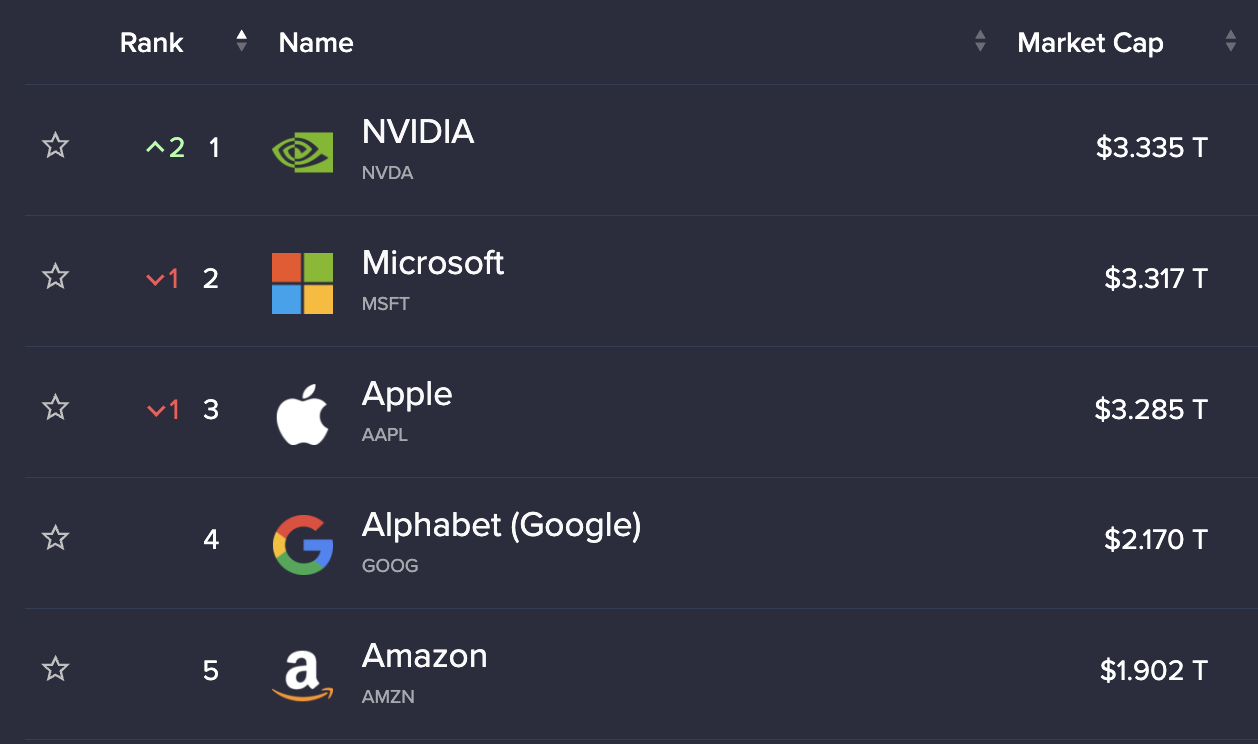Just two weeks ago, I wrote about Nvidia surpassing Apple, stating, “From a momentum standpoint, I believe it is possible for Nvidia to surpass Microsoft and become the most valuable company in the world.”
But little did I expect it to happen so quickly—in just two weeks. My gawd.

I believe most people didn’t anticipate Nvidia’s extraordinary run, yet it continues to soar.
How much longer can you keep going, Nvidia?
In the previous post, I also mentioned, “Furthermore, I think being the first company to hit a $4 trillion market cap remains a possibility.”
Now, I’ll give you 5 reasons why Nvidia can reach a $4 trillion market cap.
#1 Nvidia is Not Expensive Because of Its High Growth
Many have argued that Nvidia’s high P/E ratio is excessive compared to the rest of Big Tech. When I shared my post on social media, I received comments pointing out Nvidia’s elevated P/E ratio.

However, they are missing a critical point: P/E alone does not justify Nvidia’s current valuation. Much of Nvidia’s value is driven by its explosive growth due to the AI boom.
By dividing their P/E ratios by their trailing 12-month EPS growth, we can calculate PEG ratios for a more accurate comparison among the top trillion-dollar companies:
- Nvidia: 0.09x
- Microsoft: 1.5x
- Apple: 3.6x
Contrary to popular belief, Nvidia is relatively cheap, while Microsoft and Apple appear expensive. Of course, Nvidia’s growth rate must be sustained to justify its current share price. While it’s likely that growth will eventually slow, predicting when that will happen is anyone’s guess.
#2 Sell Shovels and Not AI
There’s a saying that it is better to sell shovels to people digging for gold, as it can be a much more lucrative business. This concept holds true even in the AI era.
Nvidia is not directly competing in the AI products market like Microsoft, Alphabet, Apple, Meta, and Amazon. Instead, these companies are buying boatloads of Nvidia GPUs to power their AI ambitions. The “shovel” business has been thriving.

While AI-related stocks have performed well, the “shovel” stocks have done even better. These include companies in the semiconductor supply chain, which help Nvidia produce its GPUs. At its core, Nvidia is a software company that outsources production to other firms like TSMC.
Semiconductor ETFs, such as SMH and SOXX, have delivered year-to-date returns of 40% or more, outperforming broader tech ETFs like XLK and QQQ. The shovel businesses continue to rake in substantial profits as AI companies invest heavily in the necessary hardware to support their development.

#3 The Next Trillion is Easier
To grow from $1 trillion to $2 trillion requires a 100% gain.
Moving from $2 trillion to $3 trillion requires a lesser 50% gain.
And to go from $3 trillion to $4 trillion only needs a 33% gain.
Essentially, it gets easier in percentage terms as the base value increases.
Nvidia is currently at $3.34 trillion and needs just another 20% increase to hit $4 trillion. Does that seem difficult? I think it’s an easy sell, especially when Nvidia’s EPS is growing at triple-digit percentages year-over-year.
Moreover, Nvidia hit the $2 trillion and $3 trillion milestones within the first half of this year. So, reaching $4 trillion in the second half of this year isn’t that unbelievable, right?
#4 Passive Funds Keep Piling on Nvidia
A significant issue with today’s passive investing is that it tends to allocate more weight to stocks that are performing well.
For instance, the Technology Select Sector SPDR Fund (XLK) will increase its allocation in Nvidia from roughly 5% to more than 20%, while reducing its allocation of Apple from about 21% to 5%.
With $66 billion in assets, this means about $10 billion will be used to buy Nvidia stock. And this is just one of many passive funds likely adding more demand for Nvidia shares.
Passive funds don’t analyze or strategize; they simply buy based on index changes. Because indices are often market-weighted, the stocks that perform well and have a larger market cap receive increased weightage, forcing passive funds to allocate even more to them. This creates a virtuous cycle where successful stocks like Nvidia continue to see inflows, further driving up their market cap.
#5 Thus, Momentum
The previous point underscores why momentum trading strategies work. A strong performer attracts more investment dollars, which in turn boosts its performance even further.
When a stock starts to rise, many investors have not yet participated. As the stock climbs higher, more investors begin to believe in it and start buying. Once they see returns, they gain confidence to invest more. After the stock has surged significantly, it triggers FOMO (Fear of Missing Out) among investors, prompting even more buying.
I believe Nvidia is already at the FOMO stage. And yes, momentum will eventually run out, but predicting when is nearly impossible. Many have labeled Nvidia a bubble since last year, yet its share price has continued to defy expectations. Stocks, especially those with strong momentum, can run longer and higher than anticipated.
While I believe Nvidia’s stock can still climb, it’s crucial not to jump in blindly. Proper risk management is essential, such as setting sell thresholds to protect against significant downturns. Without risk management, a price collapse can be devastating.
If you’re not participating in the run, cheer from the sidelines and don’t be a sour grape. Without this AI-driven surge, the stock market would have likely delivered negative returns!

